Pisz 2023-01-03
PKP Orzysz, Ełk, Biała Piska, Pisz.
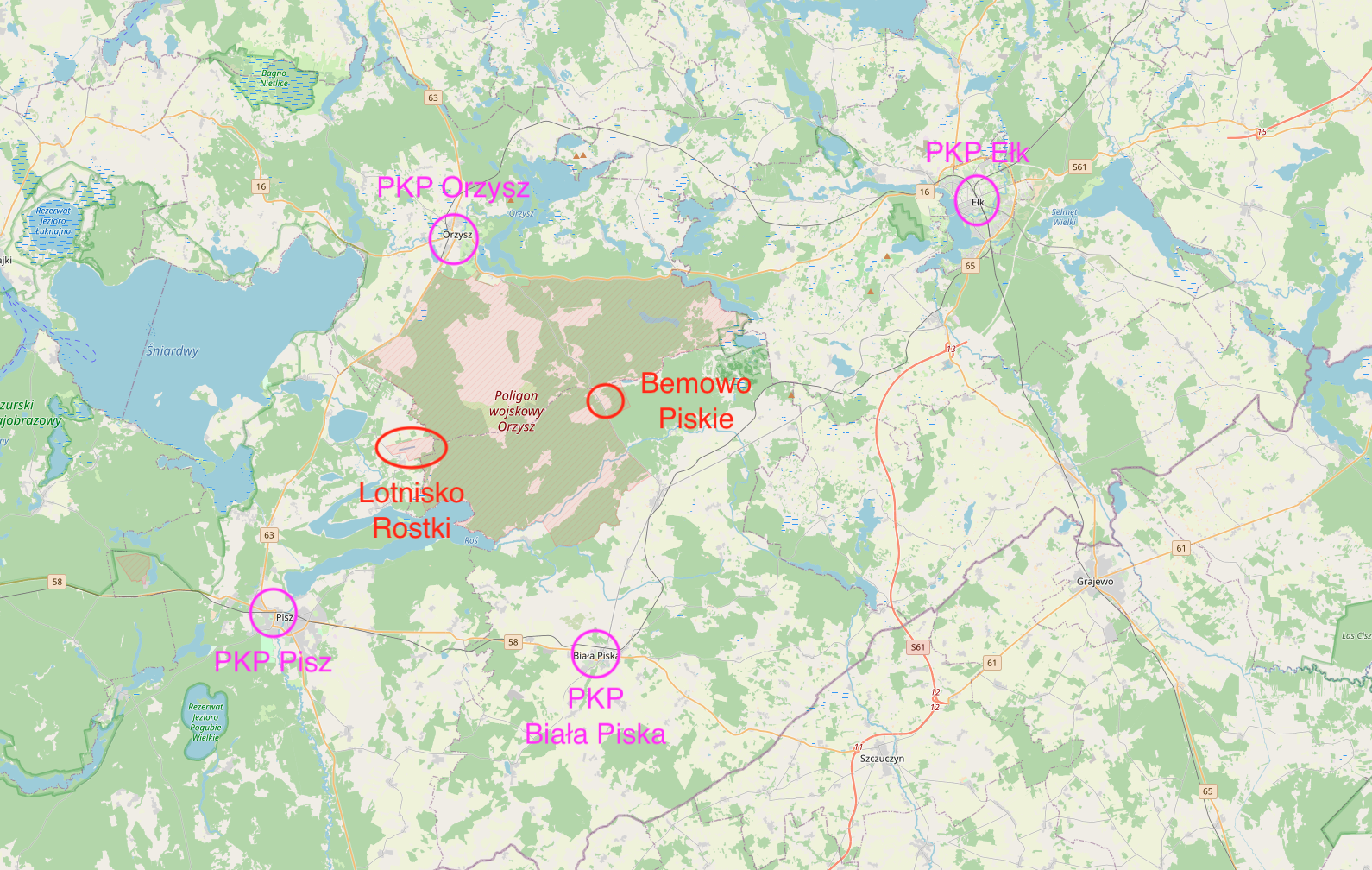
The area we are interested in is located in a quadrangle defined by four cities: Orzysz, Ełk, Biała Piska and Pisz. This area is located in Masuria and for most of its history it belonged to the Polish Crown, and then to East Prussia, which in 1772 was seized by Germanic tribes, after murdering the indigenous inhabitants - Yotvingians and Prussians. It was successively; The Province of Prussia in the period 1772 - 1871, Prussia in the period 1871 - 1918, the German Empire in the period 1919 - 1933, the Weimar Republic of the Third Reich in the period 1933 - 1945. During the Great World War, in the period 1914 - 1915, the Great Lakes area was Muscovites. Despite Germany losing the war, East Prussia remained under German administration. In 1920, a plebiscite was held among the local population, which opted for belonging to East Prussia. As a result of the Second World War started by the Germans and Muscovites, in 1945, this area was incorporated into the Republic of Poland. Administratively, the Warmińsko-Mazurskie Voivodship is here.
At the beginning of the 20th century, the Orzysz training ground was very well connected by rail. The station in Pisz was launched on November 15, 1884. The Biała Piska station was launched in 1885. The station in Orzysz was opened in 1905. Practically on each side of the training ground there were standard-gauge railway routes. The routes were created with the support of the state, for the development of the most backward parts of East Prussia and for importing goods from the Middle East through Russia.
The city of Orzysz.
Orzysz received a town parish in 1725. The area of the city is 8.17 square kilometers. The population in 2014 was 5,797 inhabitants, and in 2017, it was 5,615 inhabitants. On November 12, 1946, the town was given the Polish name of Orzysz, which is a polonised Latin name. The development of the village dates back to the 16th century, in connection with the trade route from Warmia towards Belarus. The town developed typically along the main trade road. The village was part of the Crown of the Kingdom of Poland as a fief. In 1701, the town was occupied by the Prussians as the Kingdom of Prussia. Even though most of the inhabitants spoke Polish, and masses were celebrated only in Polish. From 1702, German settlement began. Even in the middle of the 18th century, the majority of inhabitants were Poles. In the period 1871 - 1945, the town of Orzysz was incorporated into Germany.
In 1890, a military training ground was established near Orzysz and from 1895, the town became a garrison town. The stationing of the Prussian army in the city contributed to its stable development.
In the period November 1914 - February 1915, the city was occupied by Muscovites. At the turn of January and February 1945, the inhabitants of Orzysz were victims of crimes committed by Muscovites. French prisoners of war and other war refugees were also killed.
After 1946, the military facilities in Orzysz were occupied by the Polish Army. Military units such as the 32nd Brigade of Operational and Tactical Missiles, the 32nd Training Center for Specialists of Missile Forces and Artillery, the 7th Disciplinary Department - JW 1370 (until 1991), the 4th Armored Cavalry Brigade, the Lithuanian-Polish Peacekeeping Battalion were stationed here , 15th Giżycko Mechanized Brigade, 15th Masurian Sapper Battalion.
During the People's Republic of Poland, a military unit operated in Orzysz, the 7th Disciplinary Department, which was mistakenly referred to as a penal unit. Military service in the unit was performed by soldiers who had a hostile attitude towards compulsory military service. All soldiers were trained in accordance with applicable regulations.
PKP Orzysz.
Geographic coordinates: 53.804N 21.938E.
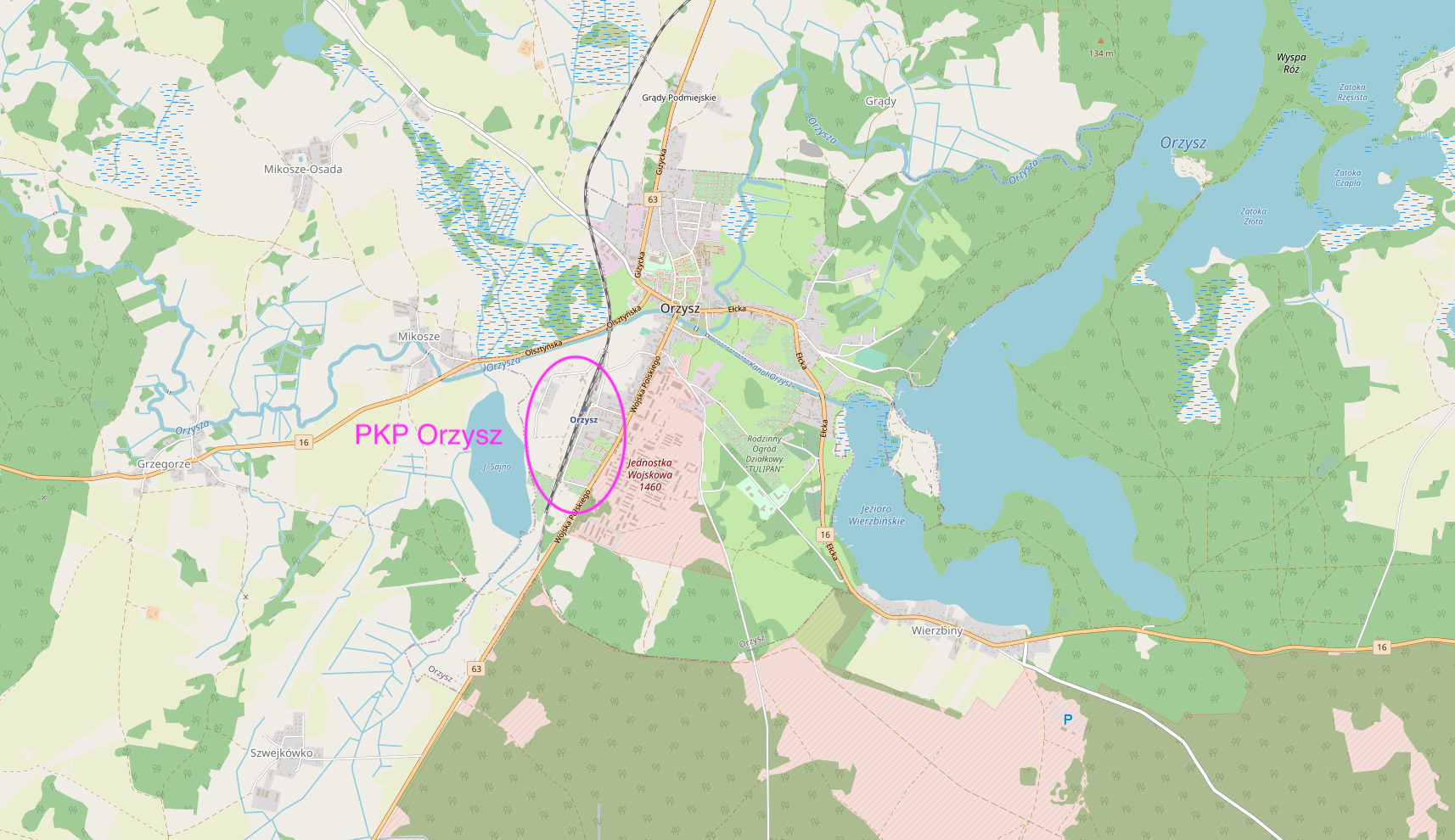
Orzysz got its first railway connection in 1906 - 1908. It was a meridional railway line, Giżycko - Pisz. The trail passed through the following villages: Upały - Ruda Staświny - Miłki - Konopki - Ublik - Pianki - Orzysz - Nowe Guty - Trzonki Snopki - Pisz. The line connected two important east-west routes: Korsze - Ełk and Olsztyn - Ełk. The first section of Giżycko - Orzysz was launched on June 1, 1906. This explains why the Orzysz railway station is arranged in the meridian direction. In 1945, Muscovites dismantled the line and took it to Moscow.
In 1911, the Mrągowo - Orzysz - Ełk railway route was built, which created the third latitudinal route: Czerwonka - Ełk. In this way, Orzysz became a junction station. But due to the theft of the Giżycko - Pisz route in 1945, Orzysz was left with only one parallel railway line, and in addition the head of the train was changed at the Orzysz station. In 2009, passenger traffic on this line was suspended. In 2018, the railway station was renovated. The military railway ramp, which is used to transport military equipment to the Orzysz - Bemowo Pilskie training ground, was renovated.
Ełk.
Ełk is the largest city in the region. The city was founded in 1425 and received city rights in 1445. The city has an area of 21.05 square kilometers. The population is 61,903 inhabitants (2020). The city belongs to the Warmian-Masurian Voivodeship. The name Ełk in its current wording was approved on May 7, 1946. Ełk is located in the Ełckie Lake District, which is part of the Masurian Lake District. The city is located on Lake Ełckie, Lake Sunowo and the River Ełk, which is a tributary of the Biebrza River.
In 1398, a brick castle was built in Ełk, near which settlements developed. The town received the right of location in 1435. In 1454, Ełk joined the Prussian Union. Under the Peace of Toruń in 1466, Ełk became part of the Kingdom of Poland, remaining as a fief under the Teutonic Knights' rule, and after the secularization of the Order in 1525, under the rule of secular Prussian princes.
During the Great World War, Ełk was badly damaged, especially in the period 1914 - 1915. During the Second World War, Ełk and its surroundings were a place of forced labor for many citizens of the occupied countries. On January 24, 1945, the Red Army entered the abandoned town of Ełk. Muscovites plundered and destroyed 50% of the city. The city was handed over to the Polish administration on April 6, 1945. On June 8, 1999, Saint John Paul II the Great visited the city.
PKP Ełk.
Geographic coordinates: 53.825N 22.363E.
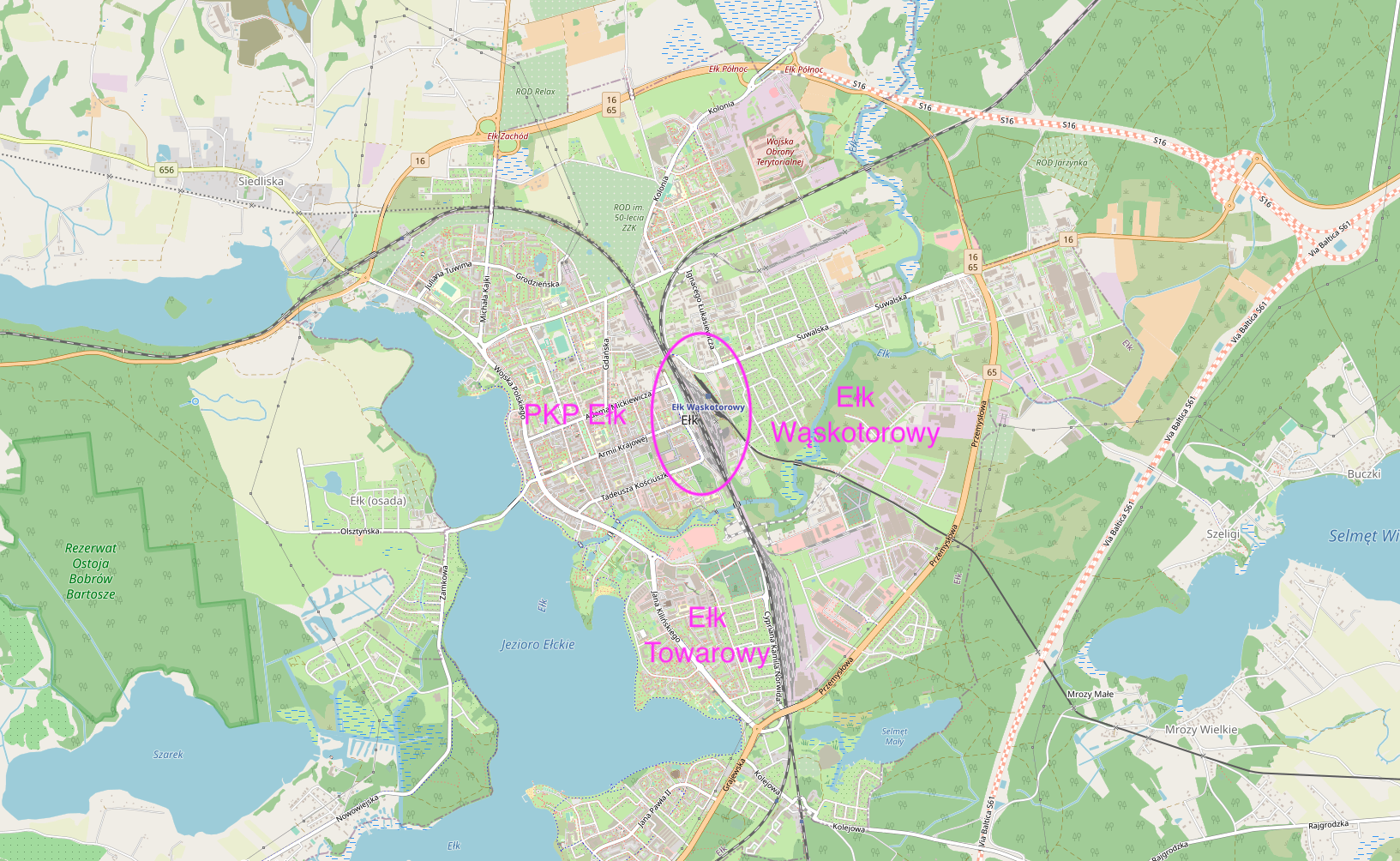
In 1868, the city of Ełk gained a railway connection with Królewiec, via Kętrzyn and Giżycko. Next, the trail led southwards to the border with the Russian partition. The railway junction in Ełk is a large and important railway junction considering the conditions of Mazury. Its history began on December 8, 1868. In 1879, the Ełk station became a junction. In the following years, more routes were created, and as a result, the station has five directions. All trails are single-track, although some sections until 1945 were double-track. All three latitudinal routes converged at the Ełk station; from Königsberg - Korsze, from Czerwonka station, from Olsztyn - Szczytno - Pisz.
The electrification of the Ełk station took place in December 1990, when electric traction was connected from the side of Grajewo. There were plans for further electrification through Giżycko, Kętrzyn to Korsze. And also the Biała Piska, Pisz, Ruciane Nida, Szczytno, Pasym, Olsztyn Główny trails. Currently, the electrification of the Giżycko - Ełk section is underway. Until May 1992, the entire Ełk junction was served by steam traction, and to a small extent by diesel traction. In the 1980s, the Elbląg station was one of the largest locomotive depots for steam engines.
Currently (2023), the Ełk railway station and the freight Ełk are undergoing major renovations. Collision-free rail-road intersections are being built. A new track system, new platforms and a new railway control system are being built. In the near future, all trains on the Ełk - Korsze section will be driven by electric locomotives.
In 1913, the Ełk Narrow-Gauge Railway was launched. This railway has been operating until now (2023) as a tourist railway.
PKP Biała Piska.
Geographic coordinates: 53.614N 22.068E.
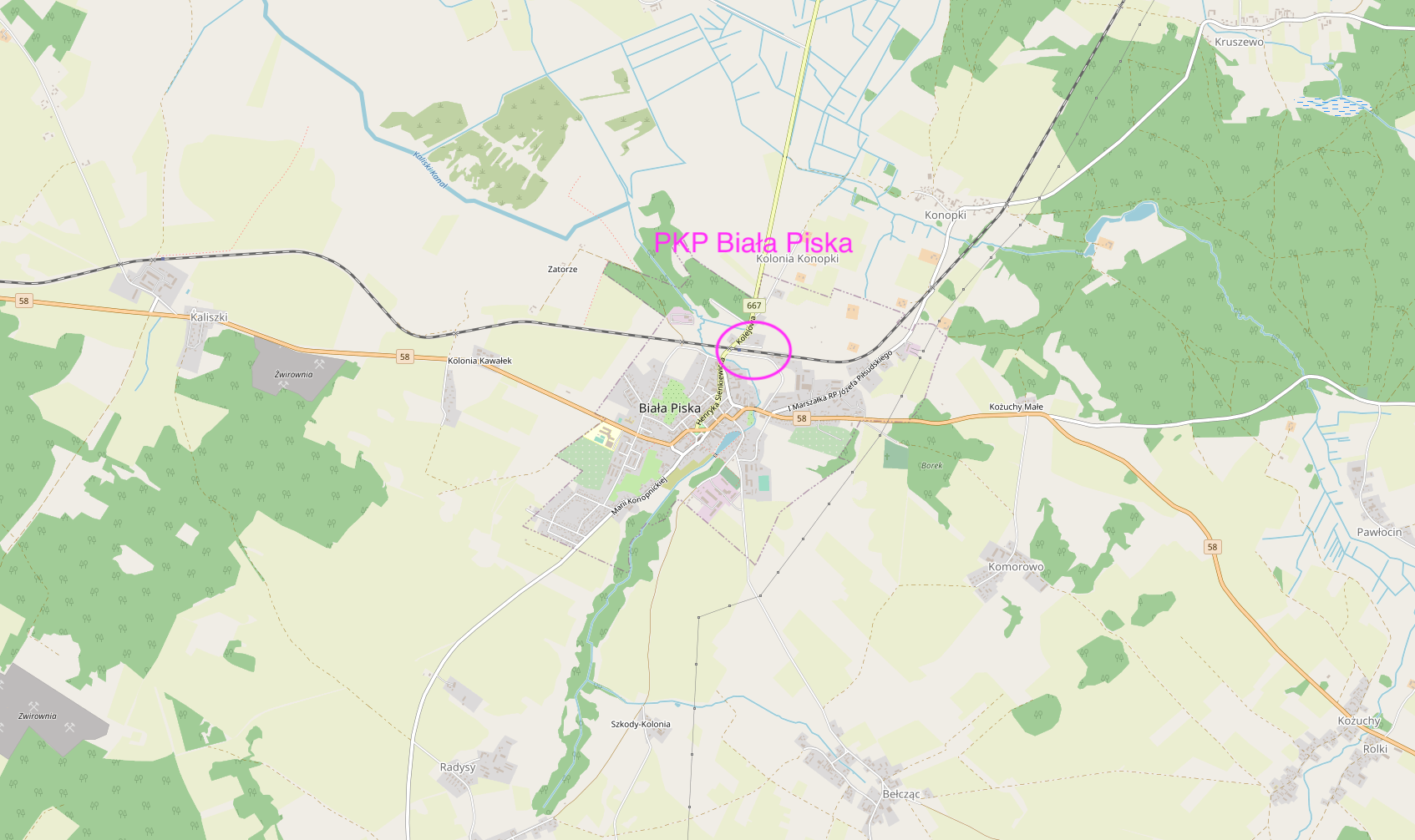
Biała Piska is a town in the Warmian-Masurian Voivodeship. The settlement was founded in the 15th century, and city rights were granted in 1722. The city has an area of 3.24 square kilometers. The population of the city is 4,083 inhabitants (2016). The construction of the Ełk – Pisz railway line in 1883 resulted in the development of the town.
PKP Pisz.
Geographic coordinates: 53.631N 21.793E.
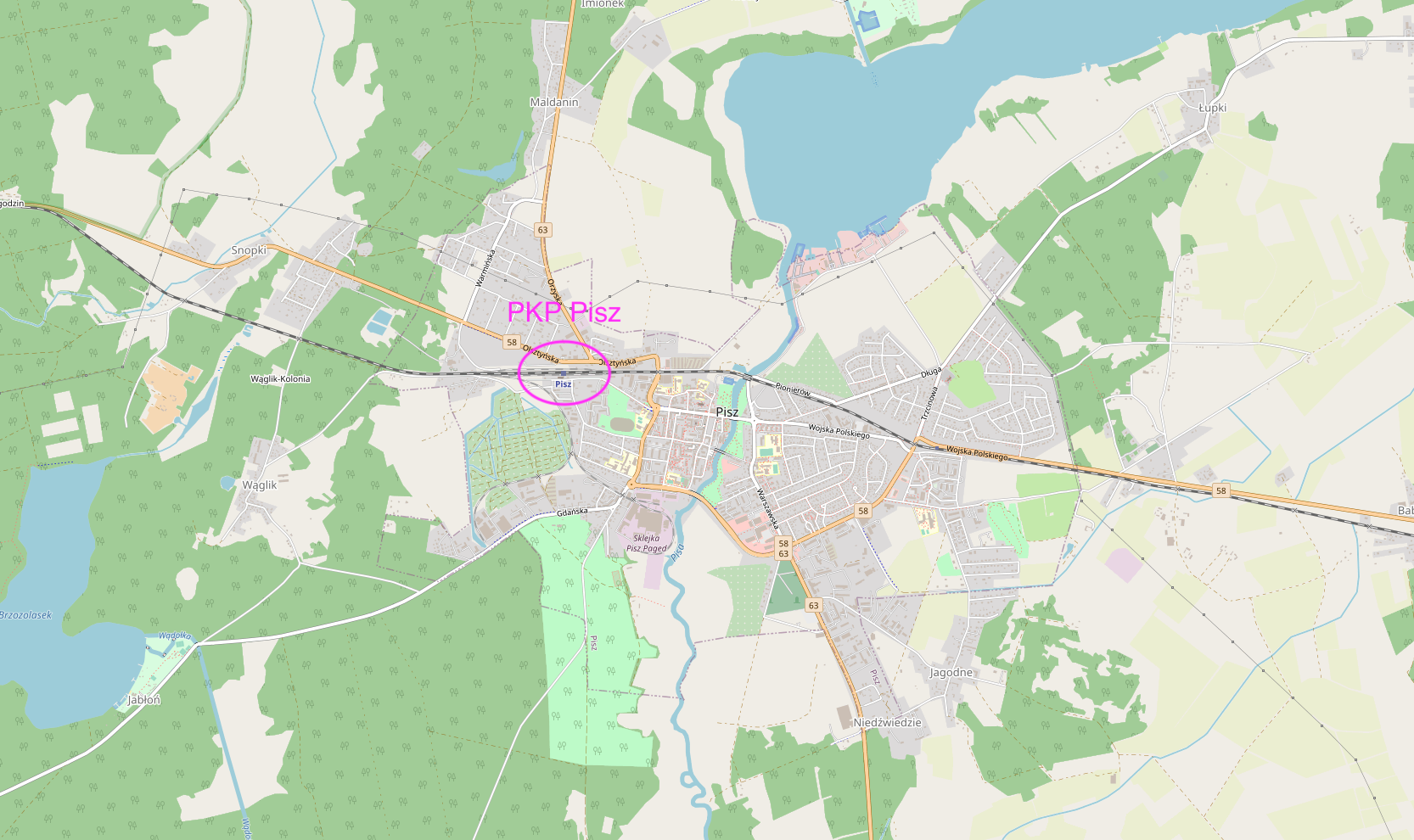
Pisz is a town in the Warmian-Masurian Voivodeship, which was founded in 1367 and received city rights in 1645. The area of the city is 10.08 square kilometers. The population is 19,386 inhabitants in 2017. The city is surrounded by the Piska Forest and lies on the Pisa River. During the Great World War, the city was destroyed twice by Muscovites. During the post-war plebiscite, the majority of the inhabitants opted for remaining within German borders. In January 1945, Muscovites entered the city and destroyed 70% of the city.
In the period 1884 - 1885, Pisz gained a railway connection with Olsztyn and Ełk. At that time, out of 49,000 inhabitants of the county, as many as 37,000 people were Poles. In 1905, a local railway line Pisz - Orzysz was built.
The water tower at the station in Pisz dates from 1919. It is an unusual shaped water tower.
Railway line No. 38: Białystok - Głomno.
Railway line No. 38: Białystok – Głomno is single-track, partially electrified. Length 241.453 km. Top speed 120 km/h. Historically, the line belonged to the Prussian railway. It was the first latitudinal line through Masuria. The first section of Królewiec - Bartoszyce was put into operation on September 24, 1866. The next section Bartoszyce - Kętrzyn was launched on November 10, 1867. The Ełk - Kętrzyn section was launched on December 8, 1868. The section Ełk - Prostki (then the border station of Prussia - Russia) was opened on November 1, 1871. The Ruthenians opened the section Białystok - Grajewo (broad-gauge) on September 15, 1873. The Grajewo - Prostki section had two tracks; normal and wide. But the main transshipment of goods was at the Prostki station. In 1894, the Korsze - Ełk route received a second track. The Königsberg - Korsze and Ełk - Prostki sections were also double-tracked.
In 1918, in the winter of the Russian partition, they returned to the reborn Poland and the wide tracks were reforged into normal ones. In 1945, the second track on the Korsze - Prostki section was stolen by the Muscovites as war booty. The electrification plan for the Ełk - Giżycko section was announced in 2020. The contract was signed on December 7, 2021. The value of the contract is approximately PLN 680 million. Electrification involves the complete modernization of tracks, stations, railway crossings and others. Work started on March 13, 2022. Due to the works, InterCity trains "Mamry" and "Niegocin" received shortened routes from the Kętrzyn side to the Giżycko station. Of course, the route on the section Korsze - Giżycko, along with electrification, was also designated for modernization. Implementation of this ago is planned in the period 2025 - 2027.
Railway line No. 223: Czerwonka - Ełk.
Railway line No. 223 Ełk - Orzysz - Mikołajki - Mrągowo - Czerwonka. The length of the line is 121.616 km. The line was, in order, the third latitudinal line through Masuria. The line is used mainly in freight traffic on individual sections. Top speed 80 km/h. The entire route was launched in 1915 as an alternative to the east-west direction for the line through Giżycko and Kętrzyn. In 1898, the section Czerwonka - Mrągowo - Ruciane Nida was opened. On October 2, 1911, the Mrągowo - Orzysz section was opened, and on June 15, 1915, the Orzysz - Ełk section.
The trail suffered little during the Great World War and developed until 1939. The trail suffered the greatest losses during the Second World War. In January - March 1945, the trail was looted and devastated by Muscovites. In the period 1947 - 1949, the route was restored to freight and passenger traffic along its entire length.
On September 1, 2009, the Ełk - Mrągowo section was closed to passenger traffic. Passenger traffic on the Mrągowo - Czerwonka section was suspended in 2010. In 2016, the section Mrągowo - Orzysz was completely closed to freight traffic, and therefore it is the only section completely closed to traffic.
In the period 2009 - 2011, the Ełk - Orzysz section was renovated. Part of the work was financed by the Polish Army. The route is mainly used by the Polish Army and other NATO allied forces that use the training ground. The maximum speed of freight trains is 80 km/h.
In the period 2018 - 2019, the Czerwonka - Mrągowo section was renovated for freight traffic. The works were carried out mainly for the chipboard factory in Biskupiec Reszelski.
Railway line No. 219 Olsztyn Główny – Ełk.
The railway line No. 219 Olsztyn Główny – Ełk is 156.032 km long. The line is single-track, non-electrified. The maximum speed is 120 km/h. Line No. 219 is the second line running from east to west in Masuria. The line is used for passenger and freight traffic.
The line was launched in sections in the period 1883 - 1885. The first section Olsztyn Główny - Szczytno was launched on November 1, 1883, the section Szczytno - Pisz was launched on August 15, 1884, the section Pisz - Ełk was launched on November 16, 1885. In 1945, the line was incorporated into Poland. The trail connects the following towns: Klewki - Marcinkowo - Pasym - Grom - Szczytno - Olszyny - Jeruty - Świątajno - Kolonia - Spychowo - Karwica Mazury - Ruciane Nida - Wide Bór - Pisz - Stare Guty - Kaliszki - Biała Piska - Drygały - Pogorzel - Bajtkowo - Nowa Wieś Ełcka - Barany - Ełk Szyby. On April 3, 2000, passenger traffic was suspended on the Pisz - Ełk section. On February 1, 2007, passenger traffic was suspended on the section Szczytno - Pisz. At the same time, the modernization of the trail began. On January 1, 2008, passenger traffic was restored on the Szczytno - Pisz section. On July 1, 2010, passenger traffic was restored on the Pisz - Ełk section. In the period 2011 - 2013, the Szczytno - Szymany section was modernized to serve the Olsztyn - Mazury airport. On March 12, 2018, the modernization of the Szczytno - Ełk section began, along with the construction of a new Pisz Wschodni passenger stop. The renovation was completed in 2019.
The entire trail has a SHP system. The line is adapted to speeds from 70 km/h to 120 km/h. Passenger transport is operated by PolRegio. The carrier uses rail buses and SZT. Interestingly, rail buses (SA106) and SZT (SA133) are often combined with an additional passenger car. Such a set has a lower commercial speed, but takes more passengers.
Shape semaphores are active at many stations. The rail traffic management system is mechanical. At the stations there are water cranes that have not yet been used. There are also loading yards and access roads paved with stone cubes. Most sidings at stations are not used and track layouts are modified during subsequent repairs. The railway routes are mostly made of S42 and S49 rails, 25 or 30 m long. The rails are laid on concrete sleepers (old type), and there are two wooden decks at the connection point. The connection of the rails is screwed with splints. During the renovation, the track is replaced with new rails and prestressed concrete sleepers. The rails are welded and are then contactless.
Popular trains. January 2023.
Trains to Białystok depart from Ełk: InterCity "Rybak" and 4 PolRegio trains. To Gdynia Główna: TLK "Biebrza". To Korsze: PolRegio. To Olsztyn: 8 PolRegio trains. To Szczecin: InterCity "Rybak". To Warszawa Wschodnia: InterCity "Biebrza". To Wrocław: InterCity "Słowacki".
Trains to Ełk depart from Giżycko: 5 PolRegio trains (replacement communication). To Gdynia: InterCity "Niegocin". To Korsze: one PolRegio train. to Olsztyn; 4 PolRegio trains. To Wrocław: InterCity "Mamry".
Written by Karol Placha Hetman
